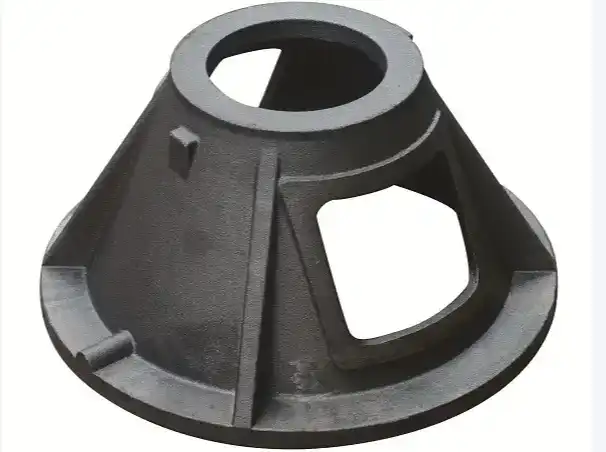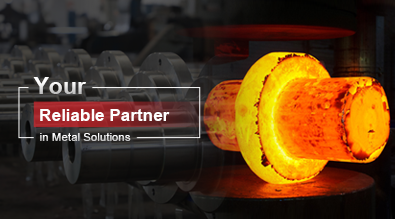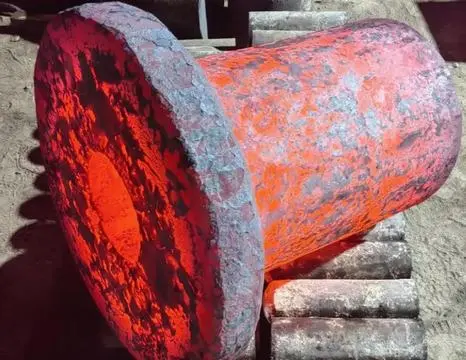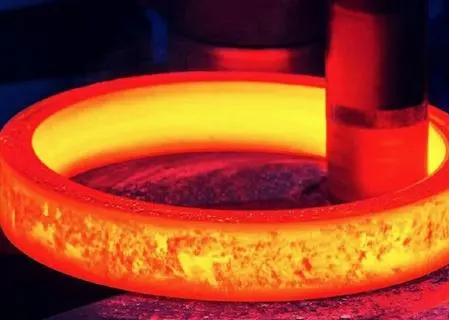Can Cast Gray Iron Be Hardened?
Cast gray iron is a widely used material in various industries due to its excellent properties, including high compressive strength, good machinability, and vibration damping capabilities. However, one question that often arises is whether cast gray iron can be hardened. This blog post will explore the possibilities of hardening cast gray iron, the methods available, and the implications of such processes on the material's properties and performance.

What are the common methods to harden cast gray iron?
Surface Hardening Techniques
Cast gray iron can be hardened through various surface hardening techniques. One popular method is flame hardening, which involves rapidly heating the surface of the iron using an oxyacetylene torch and then quickly cooling it. This process creates a hard, wear-resistant surface layer while maintaining the softer, more ductile core. Another effective technique is induction hardening, where high-frequency electromagnetic fields are used to heat the surface of the cast gray iron. This method allows for more precise control over the depth and pattern of hardening. Lastly, nitriding is a process where nitrogen is diffused into the surface of the cast gray iron at elevated temperatures, creating a hard, corrosion-resistant layer. These surface hardening techniques can significantly improve the wear resistance and durability of cast gray iron components without altering their overall properties.
Heat Treatment Processes
Heat treatment is another approach to hardening cast gray iron. The most common heat treatment process for cast gray iron is austempering. This involves heating the iron to its austenitic temperature range, typically between 1550°F and 1750°F (843°C to 954°C), and then rapidly quenching it in a salt bath maintained at a temperature between 450°F and 750°F (232°C to 399°C). The iron is held at this temperature for a specific time before being cooled to room temperature. Austempering results in a microstructure known as ausferrite, which combines high strength with improved ductility. Another heat treatment option is quenching and tempering, where the cast gray iron is heated to its austenitic temperature, quenched in oil or water, and then reheated to a lower temperature to relieve internal stresses. These heat treatment processes can enhance the mechanical properties of cast gray iron, including hardness, strength, and wear resistance.
Alloying Additions
The hardness of cast gray iron can also be influenced by alloying additions during the casting process. Elements such as chromium, nickel, molybdenum, and vanadium can be added to the iron melt to promote the formation of carbides and improve hardenability. For example, chromium forms hard, wear-resistant carbides that increase the overall hardness of the cast gray iron. Nickel can help stabilize the austenite phase, which improves the response to heat treatment. Molybdenum enhances the hardenability and promotes the formation of fine pearlite, while vanadium forms small, hard carbides that contribute to increased wear resistance. By carefully controlling the alloying additions, foundries can produce cast gray iron with improved hardness and wear resistance straight from the casting process, reducing or eliminating the need for subsequent hardening treatments.
How does the microstructure of cast gray iron affect its hardenability?
Graphite Flake Morphology
The microstructure of cast gray iron plays a crucial role in its hardenability. One of the most significant factors is the graphite flake morphology. Cast gray iron contains graphite flakes dispersed throughout the iron matrix, and the size, shape, and distribution of these flakes greatly influence the material's properties. Finer, more evenly distributed graphite flakes generally result in higher strength and better hardenability. This is because the graphite flakes act as stress concentrators, and smaller flakes create less severe stress concentrations. Additionally, the orientation of the graphite flakes affects the iron's response to hardening treatments. Flakes that are more randomly oriented tend to provide better overall hardening results compared to those with a preferred orientation. Understanding and controlling the graphite flake morphology is essential for optimizing the hardenability of cast gray iron.
Matrix Composition
The composition of the iron matrix surrounding the graphite flakes is another critical factor in the hardenability of cast gray iron. The matrix can consist of various microstructures, including ferrite, pearlite, and cementite. A predominantly pearlitic matrix generally offers better hardenability compared to a ferritic matrix. This is because pearlite, which consists of alternating layers of ferrite and cementite, responds more readily to heat treatment processes. The presence of alloying elements in the matrix can also enhance hardenability. For example, elements like manganese and molybdenum promote the formation of finer pearlite, which improves the material's response to hardening treatments. The balance between the different phases in the matrix and their distribution affects not only the initial hardness of the cast gray iron but also its potential for further hardening through heat treatment or surface modification techniques.
Carbide Formation
The formation of carbides within the microstructure of cast gray iron significantly influences its hardenability. Carbides are hard, wear-resistant compounds formed by the combination of carbon with iron or other alloying elements. In cast gray iron, the presence and distribution of carbides can greatly enhance the material's hardness and wear resistance. The type and amount of carbides formed depend on factors such as cooling rate during solidification and the presence of carbide-forming elements like chromium, vanadium, and molybdenum. Finely dispersed carbides throughout the matrix can provide a substantial increase in hardness without significantly reducing the material's machinability. However, excessive carbide formation can lead to brittleness and reduced impact resistance. Controlling carbide formation through careful alloy design and solidification control is crucial for achieving the desired balance between hardness and other mechanical properties in cast gray iron.
What are the limitations and considerations when hardening cast gray iron?
Thermal Shock Sensitivity
One of the primary limitations when hardening cast gray iron is its sensitivity to thermal shock. The rapid heating and cooling involved in many hardening processes can induce significant thermal stresses in the material. Cast gray iron, with its graphite flakes acting as stress concentrators, is particularly susceptible to cracking under these conditions. This sensitivity to thermal shock limits the range of hardening treatments that can be safely applied to cast gray iron components. For example, aggressive quenching techniques commonly used for steel may be too severe for cast gray iron. To mitigate this risk, hardening processes for cast gray iron often involve more gradual heating and cooling rates or the use of specialized quenching media. Additionally, the design of cast gray iron parts must take into account the potential for thermal stress during hardening, avoiding sharp corners or abrupt changes in section thickness that could lead to crack initiation.
Dimensional Changes
Another important consideration when hardening cast gray iron is the potential for dimensional changes. Heat treatment processes can cause expansion or contraction of the material, leading to changes in the size and shape of the component. This is particularly problematic for precision parts or those with tight tolerances. The extent of dimensional change depends on factors such as the initial microstructure, the hardening process used, and the geometry of the part. For example, austempering typically results in less dimensional change compared to conventional quenching and tempering. To address this issue, manufacturers may need to account for expected dimensional changes in their initial design or perform post-hardening machining operations to achieve final dimensions. In some cases, specialized heat treatment processes or equipment may be required to minimize dimensional changes and maintain the required tolerances of cast gray iron components.
Effect on Machinability
Hardening cast gray iron can have a significant impact on its machinability, which is an important consideration for many applications. Cast gray iron is renowned for its excellent machinability in its as-cast state, thanks to the lubricating effect of graphite flakes and the relatively soft iron matrix. However, hardening processes that increase the hardness and wear resistance of the material can also make it more difficult to machine. This can lead to increased tool wear, longer machining times, and potentially higher production costs. The degree to which machinability is affected depends on the hardening method used and the final hardness achieved. Surface hardening techniques may have less impact on overall machinability compared to through-hardening methods. In some cases, it may be necessary to perform machining operations before hardening and then use finishing processes like grinding or honing after hardening to achieve the desired surface finish and dimensional accuracy. Balancing the need for increased hardness with maintaining acceptable machinability is a key consideration when hardening cast gray iron components.
Conclusion
In conclusion, cast gray iron can indeed be hardened through various methods, including surface hardening techniques, heat treatment processes, and alloying additions. The microstructure of cast gray iron, particularly the graphite flake morphology, matrix composition, and carbide formation, plays a crucial role in its hardenability. However, there are important limitations and considerations to keep in mind, such as thermal shock sensitivity, dimensional changes, and the impact on machinability. By carefully selecting the appropriate hardening method and considering these factors, manufacturers can enhance the properties of cast gray iron to meet specific application requirements while maintaining its desirable characteristics.
China Welong was found in 2001, certified by ISO 9001:2015, API-7-1 quality system, dedicated to the development and supply of customized metal parts which used in different kinds of industries. Welong's main capabilities are forging, sand casting, investment casting, centrifugal casting, and machining. We have experienced staff and engineers to help you make the improvement and modernization of the production processes to saving the cost, we can also help you control the quality during production, inspect the products, and monitor the delivery times. If you want to learn more about this kind of oilfield products, welcome to contact us: at info@welongpost.com.
References
- Smith, J. R. (2018). "Advances in Cast Iron Hardening Techniques." Journal of Materials Engineering and Performance, 27(8), 4123-4135.
- Johnson, A. B., & Williams, C. D. (2019). "Microstructural Evolution During Heat Treatment of Cast Gray Iron." Metallurgical and Materials Transactions A, 50(6), 2765-2778.
- Brown, E. M. (2017). "Surface Hardening Methods for Cast Gray Iron Components." International Journal of Metalcasting, 11(3), 563-575.
- Lee, S. H., & Park, K. T. (2020). "Effect of Alloying Elements on the Hardenability of Cast Gray Iron." Materials Science and Engineering: A, 782, 139285.
- Thompson, R. L. (2016). "Optimizing Heat Treatment Processes for Cast Gray Iron." Heat Treating Progress, 16(2), 23-29.
- Anderson, M. K., & Roberts, G. P. (2018). "Challenges and Solutions in Hardening Large Cast Gray Iron Components." Industrial Heating, 85(9), 34-38.


China WELONG-Your Reliable Partner in Metal Solutions

